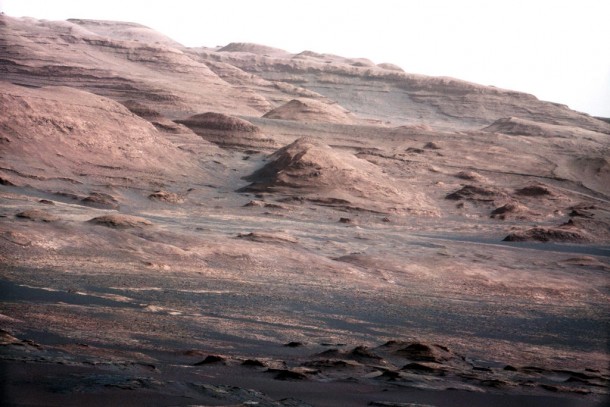NASA’s Curiosity rover has beamed back spectacular HD photos of the Martian surface.
Captured by a 100-millimeter telephoto lens and 34-milllimeter wide angle lens, the images show the dark dunes, layered rock and canyons of Mount Sharp, a mountain inside Gale Crater, where the rover landed.
NASA also released photos of Curiosity at work as it prepares to explore the Red Planet.
In another feat, Curiosity received and beamed back the first human voice transmission to travel from Earth to another planet and back.
The voice was that of NASA Administrator, Charles Bolden. The message was radioed to Mars, where it was received and then retransmitted back to Earth by Curiosity. Here on Earth, the return signal from Mars was picked up by NASA’s Deep Space Network (DSN).

Up close is the gravelly area around the rover’s landing site while in the distance is Mt. Sharp, Curiosity’s eventual destination. (NASA)

This image highlights the varied geology of Mount Sharp, a mountain inside Gale Crater, where the rover landed. (NASA)

The two donut-shaped tracks make an infinity symbol and mark Curiosity’s first two drives. The landing site is at the far right. (NASA)
In his message, Bolden noted the difficulties of putting a rover on Mars and congratulated NASA employees and all involved with the project on the successful landing. He also commented on how curiosity is what drives humans to explore.
“The knowledge we hope to gain from our observation and analysis of Gale Crater will tell us much about the possibility of life on Mars as well as the past and future possibilities for our own planet. Curiosity will bring benefits to Earth and inspire a new generation of scientists and explorers, as it prepares the way for a human mission in the not too distant future,” Bolden said in his recorded message.
The rover is also busy stretching its legs, recently taking a couple of test drives near its landing spot.
Curiosity is already sending more data from the Martian surface than all of NASA’s earlier rovers combined, the space agency said.
Members of NASA’s Mars Science Laboratory mission listen to a voice message from NASA Administrator Charles Bolden in the mission support area at the Jet Propulsion Laboratory



 Science World is VOA’s on-air and online magazine covering science, health, technology and the environment.
Science World is VOA’s on-air and online magazine covering science, health, technology and the environment.